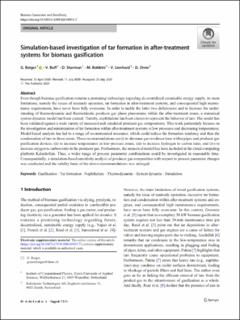Please use this identifier to cite or link to this item:
https://doi.org/10.21256/zhaw-20375Full metadata record
| DC Field | Value | Language |
|---|---|---|
| dc.contributor.author | Boiger, Gernot Kurt | - |
| dc.contributor.author | Buff, Vincent | - |
| dc.contributor.author | Sharman, Darren | - |
| dc.contributor.author | Boldrini, Marlon | - |
| dc.contributor.author | Lienhard, Viktor | - |
| dc.contributor.author | Drew, Dominic | - |
| dc.date.accessioned | 2020-08-24T08:14:32Z | - |
| dc.date.available | 2020-08-24T08:14:32Z | - |
| dc.date.issued | 2020 | - |
| dc.identifier.issn | 2190-6815 | de_CH |
| dc.identifier.issn | 2190-6823 | de_CH |
| dc.identifier.uri | https://digitalcollection.zhaw.ch/handle/11475/20375 | - |
| dc.description.abstract | Even-though biomass-gasification remains a promising technology regarding de-centralized sustainable energy supply, its main limitations, namely the issues of unsteady operation, tar-formation in after-treatment systems and consequential high maintenance requirements, have never been fully overcome. In order to tackle the latter two deficiencies and to increase the understanding of thermodynamic and thermokinetic producer gas phase phenomena within the after-treatment zones, a numerical system-dynamic model has been created. Thereby naphthalene has been chosen to represent the behaviour of tars. The model has been validated against a wide variety of measured and simulated producer-gas compositions. This work particularly focuses on the investigation and minimization of tar-formation within after-treatment systems at low-pressures and decreasing temperatures. Model-based analysis has led to a range of recommended measures, which could reduce the formation tendency and thus the condensation of tars in those zones. These recommendations are i) to decrease gas residence time within pipes and producer gas purification devices; ii) to increase temperatures in low-pressure zones; iii) to increase hydrogen to carbon ratio as well as iv) to increase oxygen to carbon ratio in the producer gas. Furthermore the numerical model has been included into the cloud-computing platform KaleidoSim. Thus a wider range of process parameter combinations could be investigated in reasonable time. Consequentially a simulation-based sensitivity analysis of producer-gas composition with respect to process parameter changes was conducted and the validity-basis of above recommendations was enlarged. | de_CH |
| dc.language.iso | en | de_CH |
| dc.publisher | Springer | de_CH |
| dc.relation.ispartof | Biomass Conversion and Biorefinery | de_CH |
| dc.rights | http://creativecommons.org/licenses/by/4.0/ | de_CH |
| dc.subject | Gasification | de_CH |
| dc.subject | Simulation | de_CH |
| dc.subject | Tar formation | de_CH |
| dc.subject | Thermodynamic | de_CH |
| dc.subject | System-dynamic | de_CH |
| dc.subject | Naphthalene | de_CH |
| dc.subject | Cloud computing | de_CH |
| dc.subject | Kaleidosim | de_CH |
| dc.subject.ddc | 660: Technische Chemie | de_CH |
| dc.title | Simulation-based investigation of tar formation in after-treatment systems for biomass gasification | de_CH |
| dc.type | Beitrag in wissenschaftlicher Zeitschrift | de_CH |
| dcterms.type | Text | de_CH |
| zhaw.departement | School of Engineering | de_CH |
| zhaw.organisationalunit | Institute of Computational Physics (ICP) | de_CH |
| dc.identifier.doi | 10.1007/s13399-020-00915-7 | de_CH |
| dc.identifier.doi | 10.21256/zhaw-20375 | - |
| zhaw.funding.eu | No | de_CH |
| zhaw.issue | 1 | de_CH |
| zhaw.originated.zhaw | Yes | de_CH |
| zhaw.pages.end | 56 | de_CH |
| zhaw.pages.start | 39 | de_CH |
| zhaw.publication.status | publishedVersion | de_CH |
| zhaw.volume | 11 | de_CH |
| zhaw.publication.review | Peer review (Publikation) | de_CH |
| zhaw.webfeed | Verfahrenstechnik | de_CH |
| zhaw.author.additional | No | de_CH |
| zhaw.display.portrait | Yes | de_CH |
| Appears in collections: | Publikationen School of Engineering | |
Files in This Item:
| File | Description | Size | Format | |
|---|---|---|---|---|
| 2020_Boiger-etal_Tar-formation-biomass-gasification.pdf | 2.53 MB | Adobe PDF |  View/Open |
Show simple item record
Boiger, G. K., Buff, V., Sharman, D., Boldrini, M., Lienhard, V., & Drew, D. (2020). Simulation-based investigation of tar formation in after-treatment systems for biomass gasification. Biomass Conversion and Biorefinery, 11(1), 39–56. https://doi.org/10.1007/s13399-020-00915-7
Boiger, G.K. et al. (2020) ‘Simulation-based investigation of tar formation in after-treatment systems for biomass gasification’, Biomass Conversion and Biorefinery, 11(1), pp. 39–56. Available at: https://doi.org/10.1007/s13399-020-00915-7.
G. K. Boiger, V. Buff, D. Sharman, M. Boldrini, V. Lienhard, and D. Drew, “Simulation-based investigation of tar formation in after-treatment systems for biomass gasification,” Biomass Conversion and Biorefinery, vol. 11, no. 1, pp. 39–56, 2020, doi: 10.1007/s13399-020-00915-7.
BOIGER, Gernot Kurt, Vincent BUFF, Darren SHARMAN, Marlon BOLDRINI, Viktor LIENHARD und Dominic DREW, 2020. Simulation-based investigation of tar formation in after-treatment systems for biomass gasification. Biomass Conversion and Biorefinery. 2020. Bd. 11, Nr. 1, S. 39–56. DOI 10.1007/s13399-020-00915-7
Boiger, Gernot Kurt, Vincent Buff, Darren Sharman, Marlon Boldrini, Viktor Lienhard, and Dominic Drew. 2020. “Simulation-Based Investigation of Tar Formation in After-Treatment Systems for Biomass Gasification.” Biomass Conversion and Biorefinery 11 (1): 39–56. https://doi.org/10.1007/s13399-020-00915-7.
Boiger, Gernot Kurt, et al. “Simulation-Based Investigation of Tar Formation in After-Treatment Systems for Biomass Gasification.” Biomass Conversion and Biorefinery, vol. 11, no. 1, 2020, pp. 39–56, https://doi.org/10.1007/s13399-020-00915-7.
Items in DSpace are protected by copyright, with all rights reserved, unless otherwise indicated.